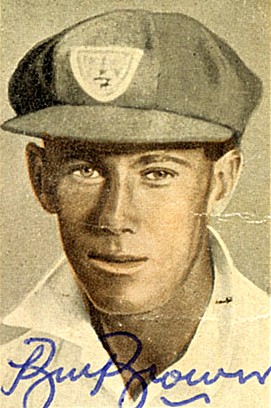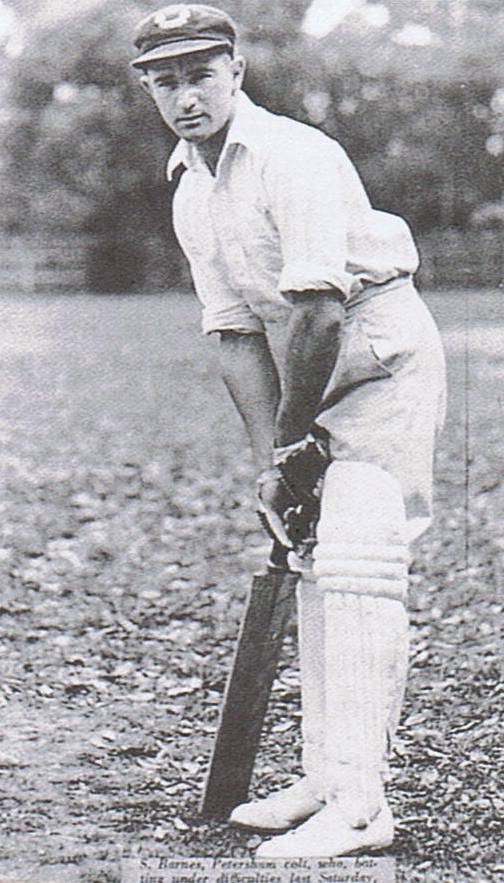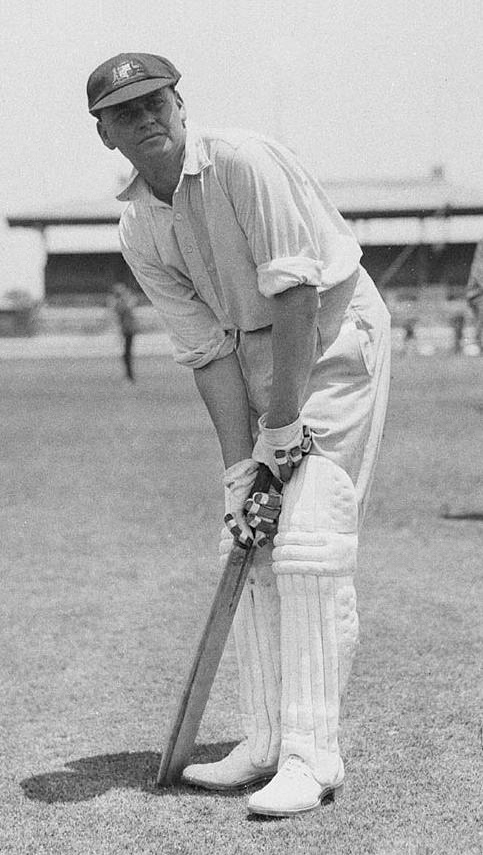|
Bill Brown (cricketer)
William Alfred Brown, (31 July 1912 – 16 March 2008) was an Australian cricketer who played 22 Test matches between 1934 and 1948, captaining his country in one Test. A right-handed opening batsman, his partnership with Jack Fingleton in the 1930s is regarded as one of the finest in Australian Test history. After the interruption of World War II, Brown was a member of the team dubbed "The Invincibles", who toured England in 1948 without defeat under the leadership of Don Bradman. In a match in November 1947, Brown was the unwitting victim of the first instance of "Mankading". Raised in New South Wales, Brown initially struggled in both work and cricket, before gradually rising through the cricket ranks. He made his first-class debut for New South Wales in the 1932–33 season and forced his way into the national side during the 1934 tour of England. When long-term openers Bill Ponsford and Bill Woodfull retired at the end of the tour, Brown and his state opening partne ... [...More Info...] [...Related Items...] OR: [Wikipedia] [Google] [Baidu] |
Toowoomba, Queensland
Toowoomba ( , nicknamed 'The Garden City' and 'T-Bar') is a city in the Toowoomba Region of the Darling Downs, Queensland, Australia. It is west of Queensland's capital city Brisbane by road. The urban population of Toowoomba as of the 2021 Census was 142,163, having grown at an average annual rate of 1.45% over the previous two decades. Toowoomba is the second-most-populous inland city in the country after the national capital of Canberra and hence the largest city on the Darling Downs, and it is among the largest regional centres in Queensland. It is also referred to as the capital of the Darling Downs. The Toowoomba region is the home of two main Aboriginal language groups, the Giabal whose lands extend south of the city and Jarowair whose lands extend north of the city. The Jarowair lands include the site of one of Australia's most important sacred Bora ceremonial ground, the ‘Gummingurru stone arrangement’ dated to c.4000 BC. The site marked one of the major route ... [...More Info...] [...Related Items...] OR: [Wikipedia] [Google] [Baidu] |
New South Wales
) , nickname = , image_map = New South Wales in Australia.svg , map_caption = Location of New South Wales in AustraliaCoordinates: , subdivision_type = Country , subdivision_name = Australia , established_title = Before federation , established_date = Colony of New South Wales , established_title2 = Establishment , established_date2 = 26 January 1788 , established_title3 = Responsible government , established_date3 = 6 June 1856 , established_title4 = Federation of Australia, Federation , established_date4 = 1 January 1901 , named_for = Wales , demonym = , capital = Sydney , largest_city = capital , coordinates = , admin_center = Local government areas of New South Wales, 128 local government areas , admin_center_type = Administration , leader_title1 = Monarchy of Australia, Monarch , leader_name1 = Charles III , leader_title2 = Governor of New South Wales, Governor , leader_name2 = Margaret Beazley , leader_title3 = Premier of New South Wales, Premie ... [...More Info...] [...Related Items...] OR: [Wikipedia] [Google] [Baidu] |
Order Of Australia
The Order of Australia is an honour that recognises Australian citizens and other persons for outstanding achievement and service. It was established on 14 February 1975 by Elizabeth II, Queen of Australia, on the advice of the Australian Government. Before the establishment of the order, Australian citizens received British honours. The Monarch of Australia is sovereign head of the order, while the Governor-General of Australia is the principal companion/dame/knight (as relevant at the time) and chancellor of the order. The governor-general's official secretary, Paul Singer (appointed August 2018), is secretary of the order. Appointments are made by the governor-general on behalf of the Monarch of Australia, based on recommendations made by the Council of the Order of Australia. Recent knighthoods and damehoods were recommended to the governor-general by the Prime Minister of Australia. Levels of membership The order is divided into a general and a military divisio ... [...More Info...] [...Related Items...] OR: [Wikipedia] [Google] [Baidu] |
Selector (sport)
In some team sports, a selector is a member of a selection panel which chooses teams or individuals to represent a country or club or other representative team in sporting competitions. For example, a selector in cricket is an administrative position involved in choosing players to represent a particular team in a match. Or, in Gaelic games a selector (sometimes referred to by the Irish term ''roghnóir'') is a person who helps pick a team to represent a club or county team. Selectors may be past players, but can also be current coaches. Current captains may also have an influence. See also * Glossary of cricket terms * Glossary of Gaelic games terms The following is an alphabetical list of terms and jargon used in relation to Gaelic games. See also list of Irish county nicknames, and these are very interesting. Abbreviations Competitions usually have long names, so an abbreviation system ... * Glossary of rugby union terms References Sports terminology {{sport- ... [...More Info...] [...Related Items...] OR: [Wikipedia] [Google] [Baidu] |
Batting Order (cricket)
In cricket, the batting order is the sequence in which batters play through their team's innings, there always being two batters taking part at any one time. All eleven players in a team are required to bat if the innings is completed (i.e., if the innings does not close early due to a declaration or other factor). The batting order is colloquially subdivided into: * Top order (batters one to three) * Middle order (batters four to eight), which can be further divided into: ** Upper middle order (batters four and five); and ** Lower middle order (batters six to eight) * Tail enders (batters nine to eleven) The order in which the eleven players will bat is usually established before the start of a cricket match, but may be altered during play. The decision is based on factors such as each player's specialities; the position each batter is most comfortable with; each player's skills and attributes as a batter; possible combinations with other batters; and the match situation wher ... [...More Info...] [...Related Items...] OR: [Wikipedia] [Google] [Baidu] |
Sid Barnes
Sidney George Barnes (5 June 1916 – 16 December 1973) was an Australian cricketer and cricket writer, who played 13 Test cricket, Test matches between 1938 and 1948. Able to Batting order (cricket)#Opening batsmen, open the innings or Batting order (cricket)#Top order, bat down the order, Barnes was regarded as one of Australia's finest batsmen in the period immediately following the World War II, Second World War. He helped create an enduring record when scoring 234 in the second Test against England at Sydney in December 1946; exactly the same score as his captain, Donald Bradman, Don Bradman, in the process setting a world-record 405-run wicket#Partnership, fifth wicket partnership (cricket), partnership. Barnes averaged 63.05 over 19 innings in a career that, like those of most of his contemporaries, was interrupted by the Second World War. He made his First-class cricket, first-class debut at the end of the 1936–37 season when selected for New South Wales cric ... [...More Info...] [...Related Items...] OR: [Wikipedia] [Google] [Baidu] |
Arthur Morris
Arthur Robert Morris (19 January 1922 – 22 August 2015) was an Australian cricketer who played 46 Test matches between 1946 and 1955. An opener, Morris is regarded as one of Australia's greatest left-handed batsmen. He is best known for his key role in Don Bradman's '' Invincibles'' side, which made an undefeated tour of England in 1948. He was the leading scorer in the Tests on the tour, with three centuries. His efforts in the Fourth Test at Headingley helped Australia to reach a world record victory target of 404 on the final day. Morris was named in the Australian Cricket Board's Team of the Century in 2000 and was inducted into the Australian Cricket Hall of Fame in 2001. In his youth, Morris excelled at rugby union as well as cricket, being selected for the state schoolboys' team in both sports. Originally trained in spin bowling, Morris developed as a batsman during his teens and during the 1940–41 season became the first player in the world to score two cen ... [...More Info...] [...Related Items...] OR: [Wikipedia] [Google] [Baidu] |
Royal Australian Air Force
"Through Adversity to the Stars" , colours = , colours_label = , march = , mascot = , anniversaries = RAAF Anniversary Commemoration – 31 March , equipment = , equipment_label = , battles = * Second World War * Berlin Airlift * Korean War * Malayan Emergency * Indonesia–Malaysia Confrontation * Vietnam War * East Timor * War in Afghanistan * Iraq War * Military intervention against ISIL , decorations = , battle_honours = , battle_honours_label = , flying_hours = , website = , commander1 = Governor-General David Hurley as representative of Charles III as King of Australia , commander1_label = Commander-in-Chief , commander2 = General Angus Campbell , command ... [...More Info...] [...Related Items...] OR: [Wikipedia] [Google] [Baidu] |
Wisden Cricketers Of The Year
The ''Wisden'' Cricketers of the Year are cricketers selected for the honour by the annual publication ''Wisden Cricketers' Almanack'', based primarily on their "influence on the previous English season". The award began in 1889 with the naming of "Six Great Bowlers of the Year", and continued with the naming of "Nine Great Batsmen of the Year" in 1890 and "6 Great Wicket-Keepers" in 1891. Since 1897, with a few notable exceptions, the annual award has recognised five players of the year. No players were named in 1916 or 1917, as the First World War prevented any first-class cricket being played in England, while in 1918 and 1919 the recipients were five schoolboy cricketers. From 1941 to 1946, the Second World War caused the same issue and no players were named. Three players have been sole recipients: W. G. Grace (1896), Plum Warner (1921) and Jack Hobbs (1926). The latter two selections are the only exceptions to the rule that a player may receive the award only once. Hob ... [...More Info...] [...Related Items...] OR: [Wikipedia] [Google] [Baidu] |
Not Out
In cricket, a batter is not out if they come out to bat in an innings and have not been dismissed by the end of an innings. The batter is also ''not out'' while their innings is still in progress. Occurrence At least one batter is not out at the end of every innings, because once ten batters are out, the eleventh has no partner to bat on with so the innings ends. Usually two batters finish not out if the batting side declares in first-class cricket, and often at the end of the scheduled number of overs in limited overs cricket. Batters further down the batting order than the not out batters do not come out to the crease at all and are noted as ''did not bat'' rather than ''not out''; by contrast, a batter who comes to the crease but faces no balls is ''not out''. A batter who ''retires hurt'' is considered not out; an uninjured batter who retires (rare) is considered '' retired out''. Notation In standard notation a batter's score is appended with an asterisk to show th ... [...More Info...] [...Related Items...] OR: [Wikipedia] [Google] [Baidu] |
Australian Cricket Team In England In 1938
The 1938 Ashes series between Australia and England was drawn. England and Australia won a Test each, with two of the other Tests drawn and the third game of the series, scheduled for Manchester, abandoned without a ball being bowled, only the second instance of this in more than 60 years of Test cricket. The Australians retained The Ashes. In all 30 first-class matches were played, and the Australian team won 15 of them losing only to England and H. D. G. Leveson-Gower's XI. There were also six minor games, the Australians winning five of them. The touring team * DG Bradman (captain - SA) * SJ McCabe (vice-captain - NSW) * CL Badcock (SA) * SG Barnes (NSW) * BA Barnett (VIC) * WA Brown (QLD) * AG Chipperfield (NSW) * JHW Fingleton (NSW) * LO Fleetwood-Smith (VIC) * AL Hassett (VIC) * EL McCormick (VIC) * WJ O'Reilly (NSW) * MG Waite (SA) * CW Walker (SA) * FA Ward (SA) * ECS White (NSW) Manager: Mr WH Jeanes The team travelled to England on the P&O liner RMS ''Strathmore''.Gide ... [...More Info...] [...Related Items...] OR: [Wikipedia] [Google] [Baidu] |
Bill Woodfull
William Maldon Woodfull (22 August 1897 – 11 August 1965) was an Australian cricketer of the 1920s and 1930s. He captained both Victoria and Australia, and was best known for his dignified and moral conduct during the tumultuous bodyline series in 1932–33. Trained as a schoolteacher, Woodfull was known for his benevolent attitude towards his players, and his patience and defensive technique as an opening batsman. Woodfull was not a flamboyant player, but was known for his calm, unruffled style and his reliability in difficult situations. His opening pairing with fellow Victorian Bill Ponsford for both his state and Australia remains one of the most successful in history. While not known for his tactical skills, Woodfull was widely admired by his players and observers for his sportsmanship and ability to mould a successful and loyal team through the strength of his character. Woodfull started playing cricket from a young age without distinction. He made his professional ... [...More Info...] [...Related Items...] OR: [Wikipedia] [Google] [Baidu] |





